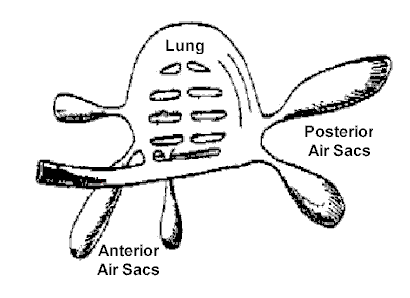Respiration
The avian respiratory system delivers oxygen from the air to the tissues and also removes carbon dioxide. The avian respiratory system is different from that of other vertebrates, with birds having relatively small lungs plus air sacs that play an important role in respiration (but are not directly involved in the exchange of gases). The air sacs permit a unidirectional flow of air through the lungs. Unidirectional flow means that air moving through bird lungs is largely 'fresh' air and has a higher oxygen content. Therefore, in bird lungs, more oxygen is available to diffuse into the blood. In contrast, air flow is "bi-directional" in mammals, moving back and forth into and out of the lungs. As a result, air coming into a mammal's lungs is mixed with 'old' air (air that has been in the lungs for a while) and this 'mixed air' has less oxygen.
The air sacs can be divided into anterior sacs and posterior sacs. Air sacs have very thin walls with few blood vessels. So, they do not play a direct role in gas exchange. Rather, they act as a 'bellows' to ventilate the lungs. The figure below demonstrates how air flows through the air sacs and lungs of a typical bird.

| 1 - On first inhalation,
air flows through the trachea & primarily into the posterior (rear)
air sacs
2 - On first exhalation, air moves from the posterior air sacs & into the lungs 3 - With the second inhalation, air moves from the lungs & into the anterior (front) air sacs 4 - With the second exhalation, air moves from the anterior air sacs back into the trachea & out |
It takes two respiratory cycles to move one "packet" of air completely through the avian respiratory system (see 1, 2, 3, and 4 above). The advantage is that air, high in oxygen content, always moves unidirectional through the lungs.